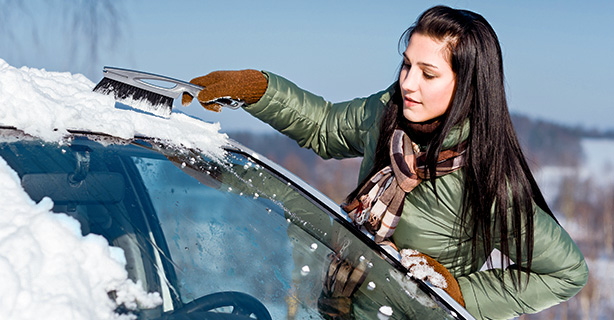How to drive in snow
Winter is here—and depending on where you call home, that could mean snow and ice out on the roads. If you're not the most comfortable venturing out in the snow, we've got tips to help you feel safer and more prepared this winter if you have to drive through poor conditions.
Clean snow and ice off your car
First things first, clean all the snow and ice off your car. To speed up the process, turn your car on and set the defroster to high. Then grab your ice scraper and brush and get to work. Once all the windows, headlights, and taillights are clear, be sure to brush any remaining snow or ice off the top of your car. If you don't, it could fly off and cause issues for another car, or slide down your windshield and obstruct your view of the road.
Slow and steady
When driving in the snow, it's important to take your time. Driving too fast in snowy or icy conditions can cause your car to slip and slide right into an accident. If you need to be somewhere at a specific time, plan ahead. Give yourself plenty of time and leave earlier than you typically would.
Maintain a safe distance from other vehicles
No matter the season, leave plenty of room between your car and other vehicles to help avoid a fender bender. This is even more important on snowy or icy roads, because if the car in front of you brakes suddenly, you'll want to give yourself more time—and more room—to stop in case your car slides. A good rule of thumb is to give yourself at least eight seconds of following distance compared to normal weather conditions.
Use the brakes
Sliding through intersections when trying to stop can be scary—and dangerous—especially with other cars around. Most modern cars are equipped with antilock brakes, which activate automatically if the vehicle notices it's sliding. In this case, step on the brake pedal, hold your foot there until the car is stopped, and keep steering. If your car isn't equipped with an antilock braking system (ABS), pump the brakes repeatedly until you come to a full stop.
Take your foot off the gas
If you're sliding on ice or your car is stuck in a foot of snow, take your foot off the gas pedal. If you're sliding on ice, remember to pump the brakes if your car doesn't have ABS, and slowly steer your car in the direction you want it to go. If your car is stuck in the snow, accelerating too quickly can jolt your car in any direction, and can get your tires wedged even deeper in the snow.
This is where planning pays off. If you expect to encounter snow, consider keeping a small shovel in your trunk to dig your tires out if needed. Additionally, spreading kitty litter around your tires can create traction and help get you out of the snow.
Keep your car stocked
If you get stuck in the snow, you may end up waiting a while for someone to come dig you out or tow your car. Prepare for such a scenario by keeping some key items in your car. Make sure you have a couple bottles of water, some granola or energy bars, and a blanket—all easily accessible.
Stay safe and warm this winter, and keep these tips in mind when you head out in the snow.
Related links
Winter weather introduces plenty of variables to keep track of, but managing your auto insurance should be a year-round priority. Check out the auto insurance coverages available from Dairyland.
The general information in this blog is for informational or entertainment purposes only. View our blog disclaimer.
*Data accuracy is subject to this article's publication date.







